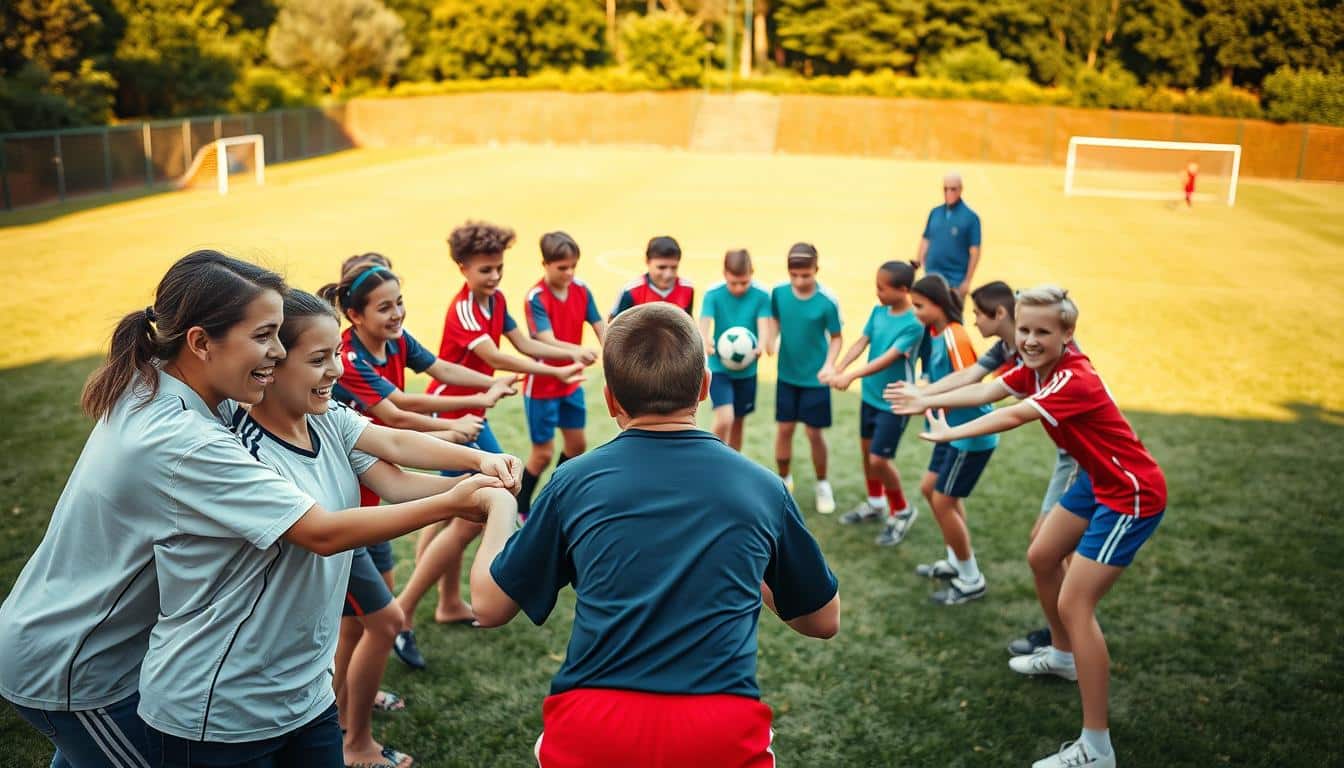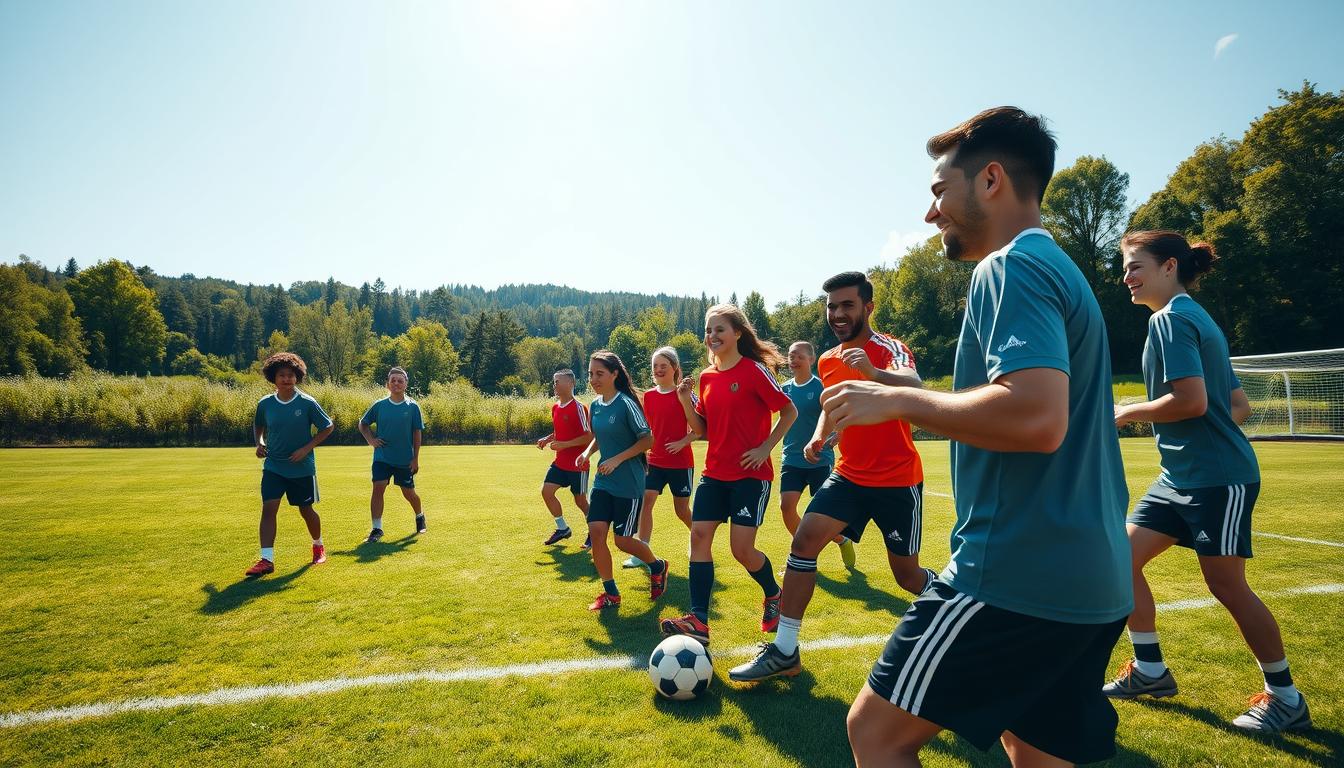Team Bonding Activities for Soccer Kids

Ever wonder how to turn a group of young athletes into a united, unstoppable force on the field? The secret lies in intentional, engaging exercises that build trust and camaraderie. For youth players, strong connections off the pitch often lead to sharper passes, quicker communication, and shared victories during games.
Great squads don’t just happen—they’re built. Simple, playful drills can break down barriers and help kids see each other as partners, not just teammates. When players genuinely enjoy spending time together, practices become more energetic, and challenges feel like shared adventures. The right mix of games and collaborative tasks creates a foundation where every child feels heard and valued.
You’ll discover how tailored experiences can transform your group’s dynamic. From laughter-filled icebreakers to problem-solving challenges, these methods teach young athletes to rely on one another. The result? A squad that celebrates wins together and lifts each other up after losses—both on and off the grass.
Key Takeaways
- Trust-building exercises improve communication during high-pressure game moments
- Group challenges encourage players to solve problems as a unit
- Shared laughter creates lasting friendships and reduces tension
- Age-appropriate activities keep engagement high across skill levels
- Strong connections lead to better support during tough matches
- Positive team culture helps every child feel important
Understanding the Role of Team Building in Youth Soccer
Strong relationships off the field fuel success during games. In youth sports, team building shapes how players interact, solve problems, and celebrate wins. These exercises teach young athletes to value collaboration over individual glory.
Enhancing Communication and Trust
Players who practice clear talking during challenges become better at calling plays. Simple tasks like blindfolded obstacle courses force them to give precise instructions. Trust grows when teammates rely on each other’s guidance to succeed.
Group puzzles or fun group games show how shared goals create unity. You’ll see quieter athletes speak up, while natural leaders learn to listen. This balance strengthens teamwork during high-pressure moments.
| Activity Type | Communication Focus | Trust Impact |
|---|---|---|
| Problem-Solving Games | Clear instruction sharing | Reliance on teammates’ ideas |
| Cooperative Drills | Active listening practice | Confidence in shared effort |
| Role-Playing Scenarios | Encouragement phrasing | Comfort in vulnerability |
Building a Positive Team Culture
Shared laughs during silly challenges become inside jokes that bond team members. These moments make practices something players anticipate rather than dread. A culture of support means every athlete feels safe to try new moves.
Celebrating small wins together—like mastering a tricky pass—builds collective pride. When setbacks occur, the group rallies instead of blaming. This mindset turns losses into learning opportunities rather than disasters.
Creative Soccer Team Bonding Activities
What if practice sessions could sharpen skills and strengthen friendships simultaneously? Mixing playful challenges with technical drills creates moments where laughter and learning collide. Young athletes thrive when exercises feel like adventures rather than obligations.
Fun Drills and Group Games
Start with the “Circle Stand-Up” – players sit shoulder-to-shoulder, lock arms, and rise together using only leg strength. This physical puzzle teaches balance and mutual support. Watch grins spread as they realize success requires synchronized effort.
The “Balance Dribble Relay” adds a twist: athletes navigate cones while balancing an object on a spoon. Focus shifts from speed to precision, with teammates cheering each careful step. Mistakes become shared jokes, not frustrations.
Pair players for a “Linked Legs Drill” where connected partners must pass a ball through obstacles. Awkward shuffles turn into coordinated strides as they decode movement patterns. You’ll hear communication improve with every stumble and recovery.
Create a makeshift “Foot Golf” course using cones as holes. Players kick balls toward targets, strategizing angles and force. This exercise sparks creative problem-solving while keeping energy levels high. Groups naturally discuss tactics, building camaraderie through friendly competition.
Soccer team bonding activities That Boost Team Spirit
Imagine a squad that moves as one unit, celebrating every victory and supporting through setbacks. The right mix of challenges and traditions turns individual talent into collective power. Coaches can spark this transformation through experiences that blend skill-building with laughter.

On-Field Challenges That Unite Players
Create a “Great Race” relay where small groups tackle soccer-related tasks. One station might involve passing through cones blindfolded while teammates shout directions. Another could require juggling the ball ten times before advancing. These activities help athletes think strategically while relying on each other’s strengths.
You’ll see players naturally encourage slower partners during obstacle courses. Mistakes become opportunities for problem-solving rather than frustration. Working together through these drills builds trust that carries into game situations.
Pre-Game Rituals for Team Confidence
Start match days with a group huddle where everyone shares one strategy. This simple ritual gives quieter athletes a voice and reminds the squad of shared goals. Follow it with a silly chant or coordinated warm-up to ease nerves.
Shared meals before competitions offer relaxed bonding time. Let teammates choose music or decorate jerseys together. These moments create inside jokes and traditions that strengthen team spirit long after the final whistle.
Outdoor and Field-Based Team Exercises
Sunlight and fresh air create the perfect backdrop for strengthening connections while honing athletic abilities. Field exercises blend physical challenges with collaborative problem-solving, helping young athletes grow as both players and teammates.
Relay Races and Obstacle Courses
Transform your practice space into an adventure zone with skill-based relays. Design races where groups dribble around cones, pass to designated spots, then shoot at mini-goals. The mix of speed and precision keeps everyone engaged while reinforcing core techniques.
Obstacle courses work wonders for building unity. Try these stations:
- Crawling under rope barriers while shielding the ball
- Weaving through poles with a partner
- Completing three accurate passes before advancing
Reward creative solutions rather than just speed. You’ll notice players naturally strategize together, blending individual strengths to beat the clock.
Cooperative Drills on the Field
Replace solo drills with challenges requiring synchronized movement. Have athletes link arms while passing through narrow channels or form human chains to protect the ball from defenders. These exercises force participants to communicate clearly and anticipate each other’s moves.
For youth squads, try “Ball Guardians” – pairs must keep possession while navigating a maze of moving opponents. The activity sharpens spatial awareness and teaches players to rely on peripheral vision. Laughter erupts as partners develop their secret signals and evasion tactics.
Off-Field Activities for Lasting Bonds
Building a tight-knit group goes beyond drills and matches. Casual gatherings let players connect as people first, athletes second. These moments create shared memories that stick long after cleats come off.
Shared Meals and Team Outings
Organize potluck dinners before weekend games. Parents bring dishes while athletes plan seating charts. Laughter over spaghetti builds bonds faster than any pep talk.
Try these low-pressure ideas:
- Park picnics with cooperative games like scavenger hunts
- Movie nights featuring sports documentaries
- Community service projects cleaning local parks
Sleepovers work wonders for youth sports groups. Players bond over board games and midnight snacks. Coaches learn which athlete fears horror movies and who makes killer pancakes.
Meet-the-Team nights kickstart seasons right. Parents connect with coaches while members design locker decorations. This sense of belonging carries through every practice and match.
These experiences help players see peers as friends, not just jersey numbers. When tough games arrive, that foundation makes all the difference.
Customizing Team Bonding for Your Soccer Team
What separates good squads from great ones? Tailored experiences that meet players where they are. A one-size-fits-all approach rarely works in youth sports – success hinges on matching challenges to your group’s unique mix.
Age & Skill Alignment Matters
Start by assessing your roster’s needs. Do they struggle with passing accuracy? Need more vocal leaders? Use this insight to pick activities targeting specific growth areas. For 5-year-olds, try 8-minute ball relays with oversized equipment. Teens might thrive in 30-minute strategy games requiring quick decisions.
- Younger athletes: Short sessions with clear rules (color-coded cones, simple scoring)
- Developing players: Focus on hand-eye coordination through balloon taps or foam ball drills
- Advanced groups: Introduce timed challenges with multiple solution paths
Coaches can tweak classic games for better fit. Swap regulation balls with softer options for nervous beginners. Add distance constraints for sharpshooters needing precision. Always make sure modifications address your crew’s current level without causing frustration.
Ball mastery exercises show how customization works. Use beanbags for footwork basics, switching to weighted spheres as skills improve. Vary passing distances weekly to match progress. This adaptive approach keeps the sport engaging while building essential techniques.
Wrapping Up Your Team Bonding Journey
The true magic happens when young athletes grow together both on and off the field. By blending skill-building with shared experiences, you create a group that thrives under pressure and celebrates every small victory. Watch how athletes who once hesitated now shout encouragement during tough matches.
Keep the momentum going all season long. Simple traditions like post-practice high-five lines or weekly shout-out circles maintain connections. Involve everyone—coaches cheering from the sidelines, parents organizing post-game snacks, and players planning fun challenges.
You’ll know it’s working when passes become crisper and laughter drowns out complaints. Those silent nods between teammates during crucial plays? That’s trust built through countless collaborative drills. The confidence to try new moves comes from knowing peers have your back.
These efforts pay dividends beyond the sport. Youth develop communication skills that help in classroom projects and future careers. Parents often report better conflict resolution at home after seasons filled with group problem-solving.
Measure progress through the little things: high-fives after missed shots, group huddles before penalty kicks, and beaming smiles when someone nails a new technique. That’s how you build not just athletes, but leaders who lift others up.
